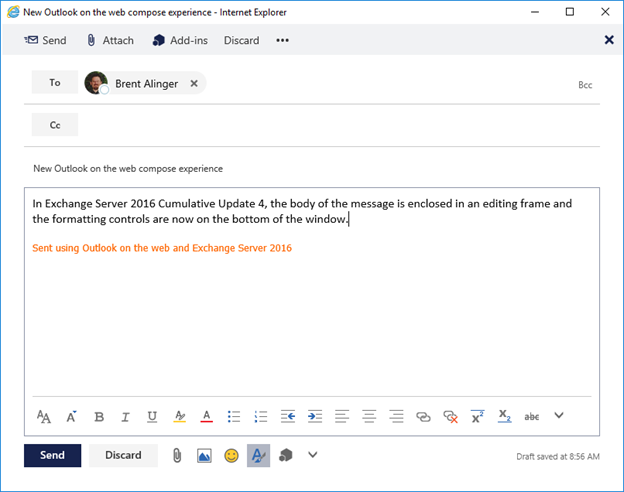Today we are announcing the latest set of Cumulative Updates for Exchange Server 2016 and Exchange Server 2013. These releases include fixes to customer reported issues and updated functionality. Exchange Server 2016 Cumulative Update 4 and Exchange Server 2013 Cumulative Update 15 are available on the Microsoft Download Center. Update Rollup 22 for Exchange Server 2007 Service Pack 3 and Update Rollup 16 for Exchange Server 2010 Service Pack 3 are also available.
A new Outlook on the web compose experience
Exchange Server 2016 Cumulative Update 4 includes a refresh to the compose experience. The body of the message is now “framed” and formatting controls have been moved to the bottom of the view. This mirrors the current experience in Office 365.
Support for .Net 4.6.2
Exchange Server 2013 and Exchange Server 2016 now fully support .Net 4.6.2 on all supported operating systems. Customers who have already updated their Exchange servers to .Net 4.6.1 can proceed with the upgrade to 4.6.2 before or after installing the cumulative updates released today. Customers who are still running .Net 4.5.2 are advised to deploy Cumulative Update 4 or Cumulative Update 15 prior to upgrading to .Net 4.6.2. The upgrade to .Net 4.6.2, while strongly encouraged, is optional with these releases. As previously disclosed, the cumulative updates released in our March 2017 quarterly updates will require .Net 4.6.2.Change to Pre-Requisites installed by Setup
Since Exchange Server 2013, the Windows feature Media Foundation has appeared as a pre-requisite in our setup checks on Windows Server 2012 and later. However, if you chose to allow Exchange setup to install the required OS Components, Desktop Experience has been installed on all supported operating systems. Desktop Experience is required on Windows Server 2008R2. The Desktop Experience feature includes additional components which are not necessary for Exchange Server and require frequent patching. Windows Server 2012 and later modified feature definitions to include Media Foundation. Exchange Setup in Exchange Server 2016 Cumulative Update 4 and Exchange Server 2013 Cumulative Update 15 has been updated to install Media Foundation instead of Desktop Experience on Windows Server 2012 and later. This change will only apply to newly installed servers. Applying either cumulative update will not change the existing configuration of the server. If desired, an administrator can add Media Foundation and remove Desktop Experience from the list of installed Windows features on Windows Server 2012 and later.Update on Windows Server 2016 support
The Windows team has released KB3206632. This update addresses the issue where IIS would crash after a DAG is formed and the server is subsequently restarted. This update is now required on all servers running Exchange Server 2016 on Windows Server 2016. Setup will not proceed unless the KB is installed.Latest time zone updates
All of the packages released today include support for time zone updates published by Microsoft through October 2016.Important Public Folder fix included in these releases
Exchange Server 2013 Cumulative Update 14 and Exchange Server Cumulative Update 3 introduced an issue where new posts to a public folder may not have been indexed if there was an active public folder migration (KB3202691). This issue is now resolved. To ensure all public folders are indexed appropriately, all public folder mailboxes should be moved to a new database after applying the appropriate cumulative update released today.Release Details
KB articles which contain greater depth on what each release includes are available as follows:- Exchange Server 2016 Cumulative Update 4 (KB3177106), Download, UM Lang Packs
- Exchange Server 2013 Cumulative Update 15 (KB3197044), Download, UM Lang Packs
- Exchange Server 2010 Service Pack 3 Update Rollup 16 (KB3184730), Download
- Exchange Server 2007 Service Pack 3 Update Rollup 22 (KB3184712), Download
Additional Information
Microsoft recommends all customers test the deployment of any update in their lab environment to determine the proper installation process for your production environment. For information on extending the schema and configuring Active Directory, please review the appropriate TechNet documentation. Also, to prevent installation issues you should ensure that the Windows PowerShell Script Execution Policy is set to “Unrestricted” on the server being upgraded or installed. To verify the policy settings, run the Get-ExecutionPolicy cmdlet from PowerShell on the machine being upgraded. If the policies are NOT set to Unrestricted you should use the resolution steps in KB981474 to adjust the settings. Reminder: Customers in hybrid deployments where Exchange is deployed on-premises and in the cloud, or who are using Exchange Online Archiving (EOA) with their on-premises Exchange deployment are required to deploy the most current (e.g., 2013 CU15, 2016 CU4) or the prior (e.g., 2013 CU14, 2016 CU3) Cumulative Update release. For the latest information on Exchange Server and product announcements please see What's New in Exchange Server 2016 and Exchange Server 2016 Release Notes. You can also find updated information on Exchange Server 2013 in What’s New in Exchange Server 2013, Release Notes and product documentation available on TechNet.Note: Documentation may not be fully available at the time this post was published.
The Exchange TeamUpdated Jul 01, 2019
Version 2.0The_Exchange_Team
Platinum Contributor
Joined April 19, 2019
Exchange Team Blog
You Had Me at EHLO.